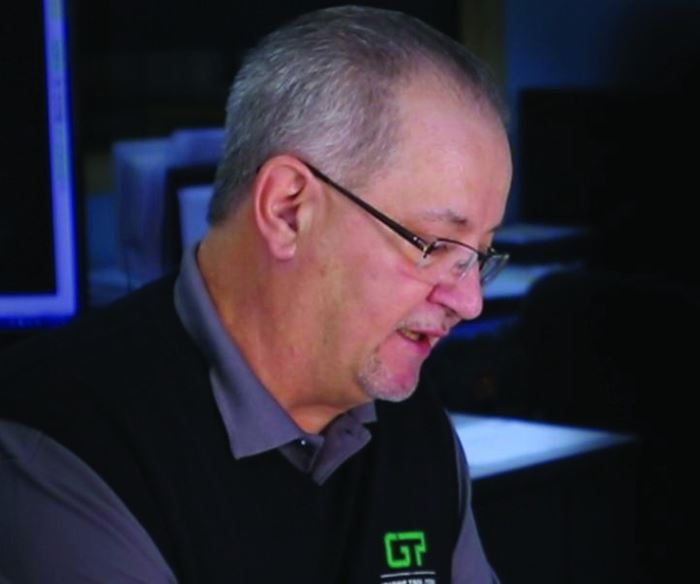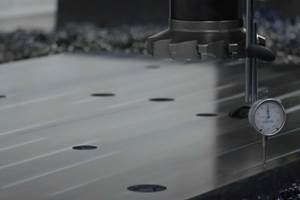Leadtime Leader Q&A Graphic Tool Corp. and Concours Mold Inc.
We invited this year’s Leadtime Leader winner and honorable mention shops to share their thoughts on five-axis machining.
How do you define five-axis machining as it pertains to Graphic Tool Corp and Concours Mold Inc.?
Don: Graphic Tool elected to pursue five-axis machining for several reasons. We wanted the ability to machine five sides of six-sided geometry in one set up, which saves us valuable time. The machine’s rigid construction and five-axis capability enables both soft and hard milling operations. Plus, we can run regular, 3D-milling routines, 3+1 or 3+2. Or, if required, we can run true five-axis milling, which expands our capabilities. Our FANUC articulating arm robot loads custom-made pallets that can hold many different workpiece shapes and sizes. This functionality allows us to perform unattended machining on multiple inserts in both a soft and hard state. We use the first-article inspection process to validate the program and, once proven, we use the robotics to feed the components through the programmed routine. This methodology allows us to run many components (soft or hard) totally unattended through the process. We routinely machine a large volume of identical inserts, rough them out and then finish them by hard milling after heat treating them to a close tolerance. We are capturing this as unattended time, which we monitor very closely. All of this lends itself to how we define five-axis milling at Graphic Tool.
Ed: Five-axis machining provides us with infinite possibilities in effectively processing part sizes and shapes. The term “five-axis” refers to the number of directions in which the cutting tool can move. On a five-axis machining center, the cutting tool moves across the X, Y and Z linear axes and rotates on the A and B axes to approach the work piece from any direction. In other words, you can process five sides of a part in a single setup. This saves time and money and ensures accuracy like never before.
For which types of jobs or workpieces do you use five-axis machines and why?
Don: Graphic uses its five-axis machines to perform five-sided machining on cores and cavities or on a variety of mold components. We purchase our steel with extra stock on one of the six sides (usually, the bottom surface of the component) so we can more easily secure the material directly to the machine pallet, magnet or in a vise. Another example is machining spiral water lines on water jackets or drilling water lines on angles. In the case of drilling water lines on angles, we would use 3+1 drilling or 3+2 machining for compound angled water lines all in the same set up. We can machine very complex undercuts that would otherwise require a time consuming and expensive electrode set, EDM operation with additional polishing. We routinely perform and finish hard-milling operations to a 0.0002 inch tolerance with total reliability. This is done as three-axis machining, or 3+1 or 3+2 machining, depending on the complexity of the geometry and the most efficient set of machining parameters for that given project. On some occasions, we finished the entire insert in our DMG MORI DMC 75V-Linear five-axis machining center and then proceeded directly to polishing.
Ed: We know all mating parts must connect precisely with others. The slightest imperfection from one clip feature on the instrument panel of a vehicle, for example, means that the glove box does not line up with the H-Vac system behind it. Before you know it, the avalanche has begun. It’s for this reason that we use our five-axis machines for all our lifters, inserts, slides and details that require the level of accuracy that we need but cannot get from using other machining resources that we have. We feel we have tuned our five-axis machines to run as fast and accurately as possible, using the machine and tooling to their optimum performance.
Based on your experience, share some “lessons learned” about five-axis machining processes and technology, and describe any aspects that you feel could be improved for moldmaking.
Don: First, select a machine tool company that has an experienced staff of factory-trained technicians who really know how to service your machine tool and can provide fast, efficient service. Additionally, select a supplier that has a trained person on staff who understands the intricate, specialized software and post processors of the five-axis machine that you will purchase. Next, consider selecting a five-axis machine tool controller that will permit you to perform certain basic programming functions at the machine tool and will help make your off-line programmer available for other tasks. Then purchase a five-axis machining vise, which will enable you to machine much closer to the part and reach places that would otherwise be inaccessible with more conventional fixtures. You will not need to extend your cutting tools nearly as far from their tool holder as you usually do, which results in a more rigid machining environment.
Graphic Tool makes extensive use of magnetic tables to hold its workpieces and vises, and Graphic Tool frequently uses shrink-fit toolholders. (We use collets and conventional toolholders for roughing only.) Both strategies result in much closer tolerances. The shrink-fit technology helps to increase machine spindle life and decrease spindle runout.
Finally, we highly recommend cross-training. The typical five-axis machine is an expensive piece of equipment, so it needs to be kept running. Cross training is an insurance policy that a purchaser of any highly complex, state-of-the-art equipment purchase should consider.
Ed: We have several five-axis machines, but it took time to learn how to maximize our use of them and figure out how to leverage the results we need. We investigated numerous cutter styles, speeds and feed rates depending on what material and function we were using. We try to optimize every situation as it comes up so that we know exactly what we’re going to get when the item is finished. At this point in time, we feel every piece that comes off our five-axis machines is spot on, and that level of optimization in our mold builds allows us to fit items faster and with less manual work. In turn, we achieve repeatability, which gives us consistency should the customer ever have a problem with any component in our tools and needs us to perform the work again.
Related Content
How to Produce More Accurate Molds and Reduce Rework
Patented micro-milling process for manufacturing steel plate flat and parallel helps mold builders shorten mold build times and increase accuracy.
Read MoreLeading Mold Manufacturers Share Best Practices for Improving Efficiency
Precise Tooling Solutions, X-Cell Tool and Mold, M&M Tool and Mold, Ameritech Die & Mold, and Cavalier Tool & Manufacturing, sit down for a fast-paced Q&A focused on strategies for improving efficiencies across their operations.
Read MoreOEE Monitoring System Addresses Root Cause of Machine Downtime
Unique sensor and patent-pending algorithm of the Amper machine analytics system measures current draw to quickly and inexpensively inform manufacturers which machines are down and why.
Read MorePredictive Manufacturing Moves Mold Builder into Advanced Medical Component Manufacturing
From a hot rod hobby, medical molds and shop performance to technology extremes, key relationships and a growth strategy, it’s obvious details matter at Eden Tool.
Read MoreRead Next
How to Use Continuing Education to Remain Competitive in Moldmaking
Continued training helps moldmakers make tooling decisions and properly use the latest cutting tool to efficiently machine high-quality molds.
Read MoreAre You a Moldmaker Considering 3D Printing? Consider the 3D Printing Workshop at NPE2024
Presentations will cover 3D printing for mold tooling, material innovation, product development, bridge production and full-scale, high-volume additive manufacturing.
Read MoreHow to Use Strategic Planning Tools, Data to Manage the Human Side of Business
Q&A with Marion Wells, MMT EAB member and founder of Human Asset Management.
Read More








.jpg;maxWidth=300;quality=90)








_300x250 1.png;maxWidth=300;quality=90)












